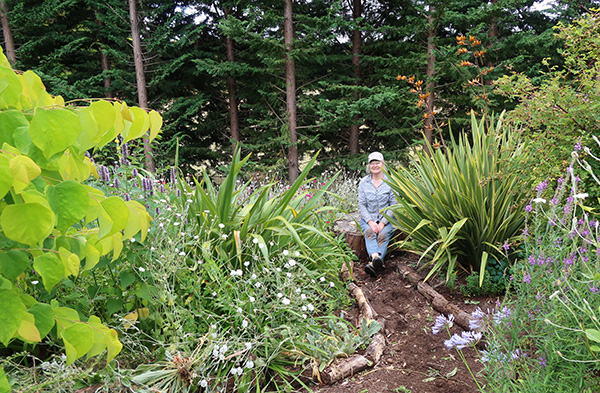Path problems
Oops. Path problems. What am I? I am a path. Where am I? In a lovely garden. Why am I? To give the lovely gardener gentle access to stuff. Am I important? Not as important as the plants and trees around me. Oh. That explains it, then.

New Path to the White Wire Seat
Sometimes paths can easily be re-routed, without too much fuss. Over-sized Anemanthele grasses get dug out, and Hydrangeas and Agapanthus are shifted out of the way. The curve (my paths like to be curved) is realigned, the edging logs moved accordingly. Lucky path!
There are rules...
But there are definite rules when a path becomes impassable. No cherished shrubs (e.g. the beautiful species rose Fenderlei) can be removed, nor can special trees (e,g, the golden leafed Cercis) be pruned. Large, desirable striped Phormiums must stay firmly in position. If the path which audaciously wiggled between these lovelies doesn't fit any more, then it's decommissioned. Gone, without a trace. No tears.
Misconceptions...
One of the many misconceptions about paths is that they need to be planned. One day, after blocking off an ill-conceived path, I stumbled through the Agapanthus to to sit on a large tree stump and think. Aha! Quickly I dug out the Agapanthus and cleared a new path to the stump. An instant destination, a perfect end-point, lovely to sit on with a cup of tea. Another misconception is that a path has to have a reason for being there. It does not. It might just look good. It might give proportion to a garden area that is too big, or oddly shaped. Or maybe the gardener just likes building paths.

Sitting on the big Stump
It does help if the gardener walks on his or her paths, though. I'd suggest that at least three times a year in three different seasons is the absolute minimum. It's too easy to get swallowed up by the greenery. However, if one of the cats or the dogs uses a path then its future is obviously much more secure.

Spring 2022 - The Hump Garden Paths are Mulched